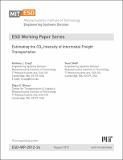| dc.contributor.author | Craig, Anthony J. | |
| dc.contributor.author | Blanco, Edgar E. | |
| dc.contributor.author | Sheffi, Yossi | |
| dc.date.accessioned | 2016-06-03T16:38:42Z | |
| dc.date.available | 2016-06-03T16:38:42Z | |
| dc.date.issued | 2012-08 | |
| dc.identifier.uri | http://hdl.handle.net/1721.1/102938 | |
| dc.description.abstract | Greenhouse gas emissions from transportation represent a significant and growing amount of total global emissions, with road freight among the fastest growing areas. Modal shift from road to rail is one of a number of proposed strategies for reducing emissions, and intermodal transport offers shippers an attractive alternative to truckload service. Unfortunately little data is available to shippers to calculate the potential savings of a modal shift. In this paper we analyze a data set of more than 400,000 intermodal shipments to calculate the CO[subscript 2] intensity of intermodal transportation as a distinct mode. We compare our results to a publicly available intermodal emissions calculator and apply the market area concept to explain the variance between individual shipments. The results provide useful guidance for shippers to estimate the potential reductions through modal shift and identify areas for intermodal operators to improve service. | en_US |
| dc.language.iso | en_US | en_US |
| dc.publisher | Massachusetts Institute of Technology. Engineering Systems Division | en_US |
| dc.relation.ispartofseries | ESD Working Papers;ESD-WP-2012-24 | |
| dc.title | Estimating the CO[subscript 2] Intensity of Intermodal Freight Transportation | en_US |
| dc.type | Working Paper | en_US |
